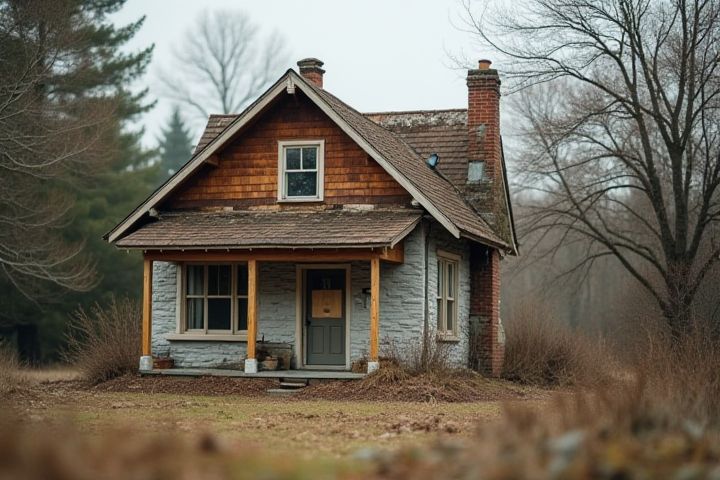
House settlement occurs primarily due to the natural movement of soil beneath the foundation, influenced by factors such as moisture changes, temperature variations, and soil composition. Clay-rich soils are particularly prone to expanding when wet and contracting when dry, leading to shifts in the foundation. Over time, inadequate drainage can exacerbate these issues, causing uneven settling and structural stress. Poorly compacted fill material used during construction can also contribute, as it may compress under weight, leading to sunk or tilted surfaces. Regular monitoring and maintenance, including foundation inspections, can help identify and mitigate settlement issues in your home.
What Causes A House To Settle
Soil compaction and consolidation
Soil compaction occurs when soil particles are pressed closer together, resulting in reduced pore space and density; this can lead to unequal distribution of weight when a house is built on top. Over time, consolidation happens as soil compression continues under the weight of the structure, causing a gradual settling process that can affect foundation stability. Factors contributing to soil compaction include moisture content, soil type, and construction methods, with clay soils being particularly susceptible to consolidation due to their fine particles. When preparing a site for construction, understanding these elements is crucial to prevent future structural issues and ensure your home maintains its integrity.
Moisture fluctuations
Moisture fluctuations in the soil surrounding your home can lead to significant settling issues. When soil absorbs water, it swells, and when it dries out, it contracts, causing shifts in the foundation. For instance, clay soils expand by up to 15% when wet and can reduce in volume by 30% upon drying, directly affecting your home's stability. Over time, these cycles can create cracks in walls, uneven floors, and compromise the overall structural integrity of your house.
Type of foundation
The type of foundation significantly influences the settling behavior of a house, with concrete slab, pier and beam, and basement foundations exhibiting distinct characteristics. Concrete slab foundations, typically resting directly on the ground, can settle unevenly due to soil moisture fluctuations and poor drainage, potentially leading to cracks. Pier and beam foundations, elevated off the ground, may shift if the supporting piers sink or if the soil underneath becomes unstable, causing noticeable adjustments in the home's structure. Basements, built into the ground, can experience issues like hydrostatic pressure from surrounding soil, causing settling or bowing walls if proper drainage measures are not maintained.
Tree root growth
Tree root growth can significantly impact a house's foundation, leading to settling issues. As roots extend underground, they can create voids or disrupt the soil structure, causing uneven support beneath the foundation. In areas with large trees, the roots may absorb moisture, drying out the surrounding soil and leading to shrinkage and subsidence. Homeowners should maintain trees within a reasonable distance from their property to minimize the risk of foundation damage caused by root systems.
Natural settling over time
Natural settling in a house occurs due to the gradual compression of soil beneath the foundation over time. Factors such as soil type, moisture levels, and weight distribution contribute significantly to this process; for instance, clay-rich soils can expand when wet and shrink during dry spells, causing foundation movement. On average, homes may settle about 1 to 2 inches in the first few years, but this settling can continue at a slower rate for decades. Understanding these dynamics is essential for homeowners to recognize normal settling versus potential structural issues.
Construction quality
Poor construction quality can significantly contribute to a house settling. Inadequate soil compaction during site preparation may lead to inconsistent foundation support, causing uneven settling as the ground shifts. Additionally, using inferior materials, such as substandard concrete or improper reinforcements, may result in structural weaknesses over time. You should consider regular inspections to identify potential issues early and maintain the integrity of your home's foundation.
Nearby construction or excavation
Nearby construction or excavation activities can significantly impact a house's structural integrity, leading to settling. Such operations disturb the soil, altering its density and load-bearing capacity, which can cause shifts in the foundation. For instance, vibrations from heavy machinery can compress or displace the ground underneath your home. It's crucial to monitor such activities within a 50-foot radius, as they can lead to cracking walls and uneven floors due to the resulting changes in soil composition.
Poor drainage
Poor drainage can significantly contribute to a house settling, often leading to structural issues. When rainwater or groundwater accumulates around a foundation, it creates hydrostatic pressure, which can cause soil erosion and destabilization. This excess moisture can weaken the soil supporting your home, leading to uneven settling and foundation cracks. Regular maintenance of gutters and downspouts, ensuring they direct water at least 6 feet away from the foundation, is crucial for preventing such problems.
Size of the structure
The size of a structure significantly influences how a house settles over time, as larger homes often have more weight and stress on the foundation. Houses exceeding 2,500 square feet may experience uneven settling if the foundation isn't adequately designed for their size, leading to cracks and structural issues. For instance, the average weight of a single-story home can range from 150 to 300 pounds per square foot, which necessitates robust foundational support. Your home's size, when coupled with soil conditions and moisture levels, plays a crucial role in determining both initial settling and long-term stability.
Seasonal changes
Seasonal changes significantly influence the settling of a house, primarily due to variations in temperature and moisture levels. During winter, colder temperatures can cause soil to contract, while spring and summer bring moisture from rainfall, leading to soil expansion as it absorbs water. These cyclical changes create pressure on the foundation, which can lead to cracks or shifts over time. You may notice these effects particularly in regions with clay-rich soils, as they are more prone to swelling and shrinking in response to moisture fluctuations.
